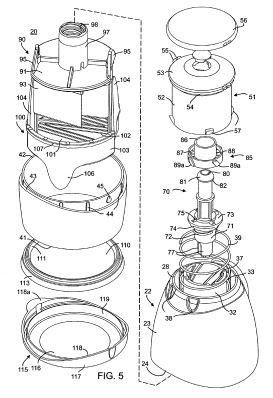Copyright © Françoise Herrmann
If you have only a small quantity of
vegetables or nuts for chopping, and prefer a bit of mechanical assistance, one of
the hand-operated OXO® choppers might be in your stars.
This particular OXO® chopper chops directly
on the cutting board, or on the base plate of its own removable food container. The Youtube OXO® manufacturer video below
will give you a glimpse of how this handy little utensil works.
This OXO® chopper invention is disclosed in
the US utility patent US7152821B2,
titled Chopper. The patent discloses a reciprocating hand-operated
food chopper. The chopper comprises a housing, designed to confine the food to be chopped by a vertical reciprocating chopping blade. The blade is attached to
a vertical reciprocating plunger assembly, spring-loaded in the raised
position. The plunger assembly has an indexing mechanism enabling the blade to
rotate a bit, each time the plunger moves up and down, and thus to comminute, or divide, food into increasingly smaller particles
The OXO® invention offers to improve on the prior
art of reciprocating hand-operated choppers by providing a bumper system within the plunger assembly both to
enhance the user’s comfort of chopping hard food on a hard surface, and to prevent vibration from causing damage to the blade assembly. Additionally, the OXO® invention offers
a stripper system designed to prevent chopped food from entering inside the
blade assembly. Finally, the OXO® chopper invention is designed both for easy manufacturing
at a cost-efficient price, and easy cleaning as it is effortlessly disassembled/reassembled and dishwasher-safe.
The abstract of the OXO® chopper invention is
included below together with the patent Figure
5, showing an exploded view of the chopper 20. The dotted lines connecting
both sides of the drawing indicate how the components on the left side of the chopper are assembled beneath those on the right side. An image of the marketed assembled OXO® chopper is included, next to the patent drawing.
On the right side of Figure 5, the exploded drawing shows, among many components of the invention, the plunger 51 with soft grip knob 56,
the shaft 70 and indexer sleeve 85. On the left
side of Figure 5, the exploded drawing shows, among many additional invention parts, the blade assembly 90 with serpentine blade 93,
the blade stripper assembly 100 with scraper extension 106, and the lower
body food container with removable base plate 110, enabling to chop on a cutting board, and cap 115, beneath the base plate 110, used for storage.
ReferenceA food chopper includes a housing for receiving a food item, a blade assembly including a blade movable within the housing for chopping the food item, a shaft attached to the blade assembly for movement therewith, a plunger assembly coupled to the shaft for effecting, reciprocating, and rotational movement thereof, and a shock absorber disposed between the plunger assembly and the shaft. The shaft is threadedly connected to the blade assembly. The chopper may include a stripper fixed to the housing and responsive to movement of the blade assembly for removing food from the blade, and first and second guide structures respectively on the blade assembly and the stripper for guiding coupling of a blade assembly to the stripper. [Abstract US7152821B2]
OXO® website
www.oxo.com



















